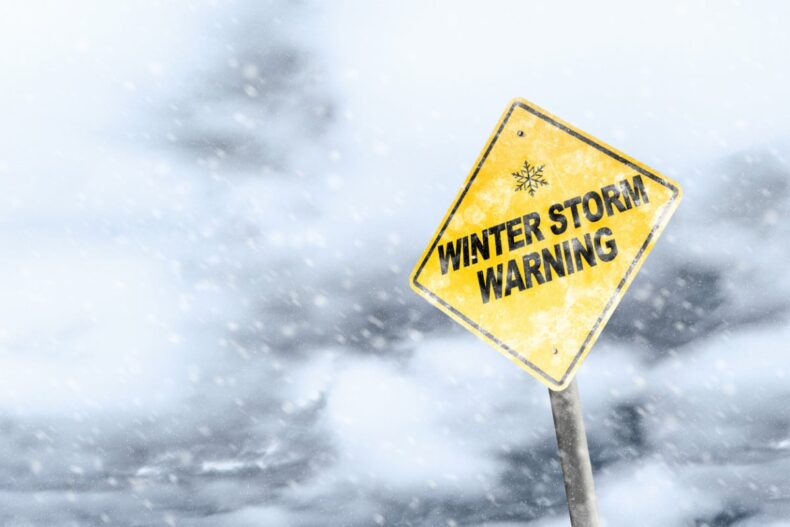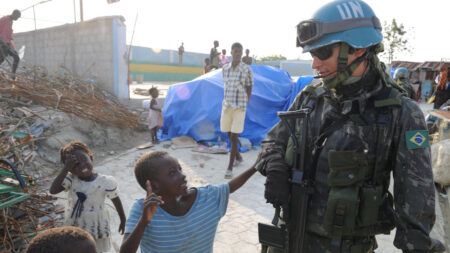Over 200 million people in the United States are under a weather warning as a winter storm causes widespread power outages and blackouts.
Winter storms are common in many parts of the United States, particularly in the northern and eastern states where cold temperatures and snowfall are more common during the winter months. These storms can bring a variety of hazardous weather conditions, including snow, ice, sleet, freezing rain, strong winds, and cold temperatures.
The frequency and severity of winter storms can vary widely depending on the region and can be influenced by a variety of factors, such as temperature, humidity, wind patterns, and the presence of other weather systems. Some areas may experience several winter storms each year, while others may only see one or two. It’s important to be prepared for the possibility of a winter storm and to take appropriate precautions to stay safe during these events.
A “bomb cyclone” (also known as a “bombogenesis” or “explosive cyclogenesis”) is a meteorological phenomenon that refers to a rapidly intensifying low-pressure system. This type of storm system typically forms over the ocean and can bring strong winds, heavy precipitation, and extreme weather conditions to the areas it impacts.
Understanding the Formation of Winter Storms and Bomb Cyclones

Winter storms and bomb cyclones are meteorological phenomena that can bring strong winds, heavy precipitation, and extreme weather conditions to the areas they impact. These storms form when a low-pressure system rapidly intensifies, with the minimum central pressure dropping significantly over a short time (typically 24 hours).
The formation of winter storms and bomb cyclones is often influenced by the presence of other weather systems, such as cold fronts or warm fronts. These systems can bring cold or warm air masses into an area, respectively, which can contribute to the development of a low-pressure system.
Other factors that can influence the formation of winter storms and bomb cyclones include temperature, humidity, and wind patterns. For example, a large temperature difference between a warm air mass and a cold air mass can help to create a low-pressure system. In addition, strong wind shear (a change in wind direction or speed over a short distance) can also help to intensify a low-pressure system.
Overall, the formation of winter storms and bomb cyclones is a complex process that is influenced by a variety of factors. By understanding these factors, we can better predict and prepare for these storms and the potential impacts they may have on communities
The Wide-Ranging Impacts of Winter Storms and Bomb Cyclones

Winter storms and bomb cyclones can bring a variety of hazardous weather conditions, including snow, ice, sleet, freezing rain, strong winds, and cold temperatures. These storms can have significant impacts on communities, including disruptions to travel and daily routines, damage to infrastructure, and risks to personal safety.
One of the major impacts of winter storms and bomb cyclones is the disruption of travel. These storms can make roads and highways slick and dangerous, making it difficult or impossible to travel by car. They can also lead to the closure of airports, making it difficult to fly. In some cases, these storms can strand travelers or cause travel delays.
Winter storms and bomb cyclones can also cause damage to infrastructures, such as power lines, buildings, and roads. Heavy snow and ice can weigh down trees and power lines, leading to power outages. Strong winds can cause damage to buildings and other structures, and heavy precipitation can lead to flooding and erosion.
In addition to these impacts, winter storms and bomb cyclones can pose risks to personal safety. Cold temperatures can be dangerous, particularly for people who are exposed to the elements for extended periods. In addition, strong winds and heavy snow can make it difficult to move around outside, increasing the risk of falls or other accidents. It’s important for people to stay informed about the weather and to take appropriate precautions to protect themselves and their families during these events.
Overall, winter storms and bomb cyclones can have wide-ranging impacts on communities, making it important for people to stay informed and prepared for these events.
Essential Steps for Protecting Yourself and Your Family During Winter Storms and Bomb Cyclones

Here are some tips for protecting yourself and your family:
- Stay informed: Keep an eye on the weather forecast and pay attention to any alerts or warnings issued by local officials. This will help you to know what to expect and to plan accordingly.
- Have an emergency kit on hand: Put together a kit of essential supplies that you may need during a winter storm or bomb cyclones, such as non-perishable food, water, flashlights, batteries, and a first-aid kit.
- Dress in warm layers: Wear multiple layers of clothing to keep warm, including a base layer, a middle layer, and an outer layer. Make sure to cover your head, hands, and feet to help retain body heat.
- Stay inside if possible: If conditions are hazardous, try to stay indoors to avoid exposure to the elements. If you must go outside, dress appropriately and be sure to cover exposed skin.
- Follow the guidance of local officials: Listen to the advice of local officials and follow any evacuation orders or other directives they may issue.
By following these tips, you can help to protect yourself and your family during a winter storm or bomb cyclone and stay safe during these events.
The Connection Between Climate Change and Winter Storms and Bomb Cyclones

There is evidence to suggest that climate change may be impacting the frequency and severity of winter storms and bomb cyclones. As the Earth’s temperature rises, the atmosphere can hold more water vapor, which can lead to heavier precipitation events. In addition, rising temperatures can lead to more extreme temperature fluctuations, which can contribute to the formation of winter storms and bomb cyclones.
While it is difficult to attribute any specific weather event to climate change, it is clear that climate change is contributing to an overall increase in the frequency and severity of extreme weather events. This includes winter storms and bomb cyclones, as well as other types of storms, such as hurricanes and typhoons.
To mitigate the impacts of winter storms and bomb cyclones, it is important to address the root cause of climate change by reducing greenhouse gas emissions. This can be done through a variety of measures, such as increasing the use of renewable energy sources, improving energy efficiency, and adopting sustainable land use practices. By taking steps to address climate change, we can help to reduce the frequency and severity of these storms and protect communities from their impacts.
Navigating the Recovery Process After a Winter Storm or Bomb Cyclone

Here are some strategies that communities can use to recover:
- Clear roads and repair damage: One of the first steps in recovery is to clear roads and other infrastructure of debris and repair any damage caused by the storm. This may involve the use of snowplows and other equipment to clear roads of snow and ice, as well as efforts to repair damaged buildings and other structures.
- Assist those affected: Many people may be affected by a winter storm or bomb cyclone, either directly or indirectly. It’s important to assist those who have been affected, whether through the provision of emergency shelter, food, or other resources.
- Restore power and other services: Winter storms and bomb cyclones can often cause power outages and other disruptions to essential services. It’s important to work to restore these services as quickly as possible to help communities get back to normal.
- Communicate with the public: It’s important to keep the public informed about recovery efforts and any updates on the situation. This can help to alleviate concerns and keep people informed about what is being done to help them.
By taking these steps, communities can work to recover from the impacts of winter storms and bomb cyclones and get back to normal as quickly as possible.
The Surprising Benefits of Extreme Weather Events

One potential benefit of winter storms and bomb cyclones is the economic boost they can provide to local communities. For example, ski resorts and other winter tourism destinations may see an increase in business during a winter storm or bomb cyclone, as people flock to these areas to enjoy the snow and cold weather. In addition, businesses that provide snow removal and other winter weather services may see an increase in demand during these events.
Another benefit of winter storms and bomb cyclones is the opportunity they provide for people to come together and help one another. In the aftermath of a winter storm or bomb cyclone, neighbors and communities may band together to help clear roads, repair damage, and assist those who have been affected. This can help to build stronger, more resilient communities and foster a sense of belonging and connection among neighbors.
Finally, winter storms and bomb cyclones can have positive impacts on the environment. For example, heavy snowfall can help to replenish water resources, while the cold temperatures associated with these storms can help to kill off pests and disease-causing organisms.
Overall, while winter storms and bomb cyclones can bring significant challenges and hazards, they can also bring some surprising benefits to communities and the environment.













